Charting the Microbial Map: What Astronauts Leave Behind
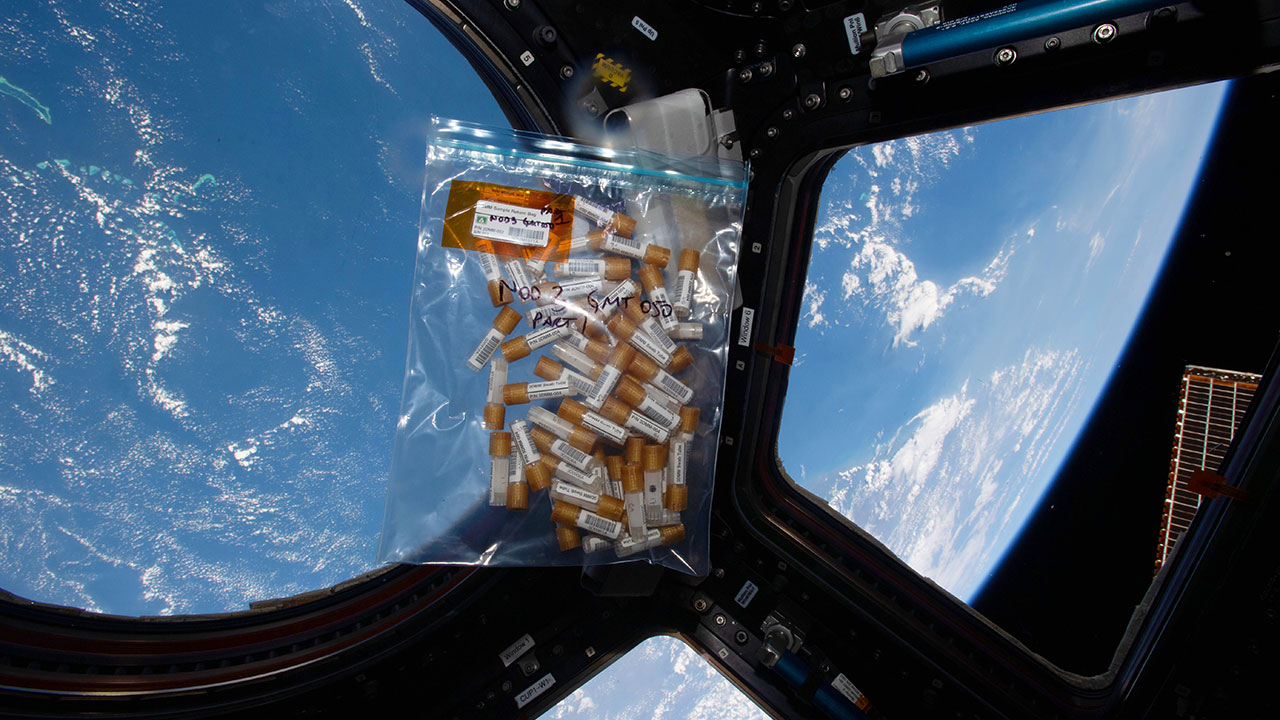
The sampling tools used to swab surfaces across the ISS for the study.
Media Credit: NASA
November 19, 2025 • By Stephenie Livingston, Staff Writer
Astronauts have company on the International Space Station (ISSInternational Space Station). Bacteria squat on handrails. Skin flakes lodge in air vents like lint. A corn-loving fungus has become a regular. The place looks spotless, but it’s crawling—its surfaces inscribed with cells and spores.
Scientists want the census, and that’s how Nina Zhao found herself opening swabs from the space station. She wasn’t expecting pepper grains, or bread mold, either, for that matter. Zhao, a postdoctoral scientist at the University of California, San Diego (UCSD), specialized in mass spectrometry, not space exploration. Yet, she and Rodolfo Salido, a Ph.D. student also at UCSD, found themselves poring over hundreds of cotton tips that had been swept across walls, toilets, and table edges by astronauts, then shipped back to Earth, like evidence from a crime scene.
To make sense of them, they relied on untargeted mass spectrometry, a tool that scans everything at once. It plots molecules as jagged peaks, showing the chemical fingerprints of whatever clung to the ISS surfaces. Matching those patterns against vast databases slowly resolved the peaks into recognizable shapes: caffeine, skin bacteria, bread mold, a pathogen or three.
“Basically, things stay on the surface,” says Zhao, a finding she found surprising. “We were still able to see the impact of human activity on the surface chemistry of the space station, even under the zero gravity conditions. It’s an incredible example of the resiliency and complexity of microbial life.”
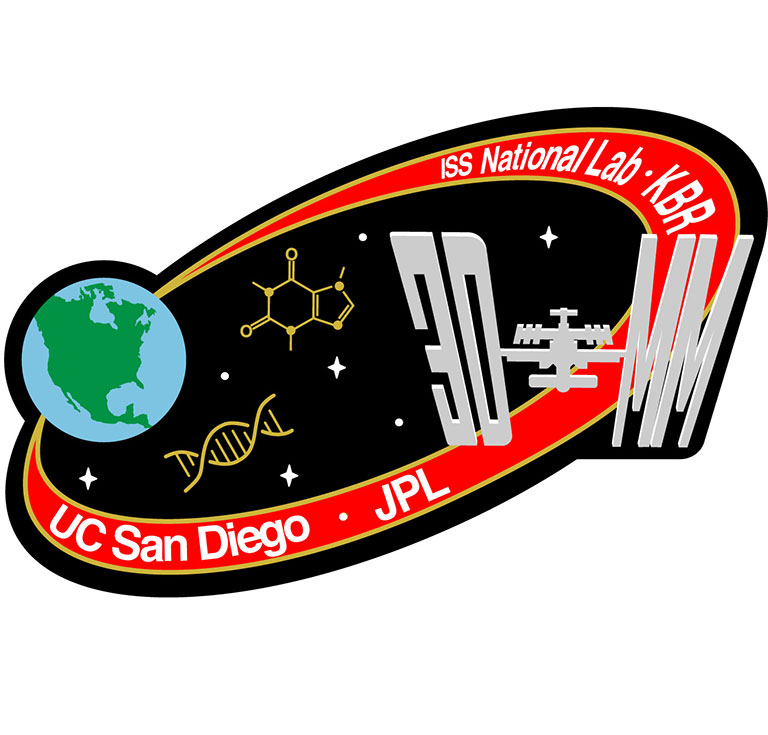
Mission patch for the Three-Dimensional Microbial Mapping (3DMM) project, which maps the microbial and chemical environment on the ISS in unprecedented detail.
Media Credit: Nina Zhao
The samples were part of a decade-long ISS microbial survey led by Kasthuri Venkateswaran at NASA’s Jet Propulsion Laboratory (JPL). An ISS National Laboratory®–sponsored investigation scaled up the project: astronauts swabbed 803 surfaces across nine modules. Using chemical and genetic profiling, researchers at UCSD and JPL built the first 3D microbial and chemical map of how humans and microbes coexist in space onboard the U.S. Orbital Segment. Published in Cell, the study showed for the first time on this scale that microbes and molecules drifted not chaotically, but in ordered, location-specific patterns, much like in homes on Earth.
In the ISS galley, Zhao’s instruments detected evidence of food and drinks. In the restroom, she found the chemical signatures of human metabolites. And like the rest of us, astronauts are prolific shedders—walking fermenters whose skin alone contributes 80 percent of the microbes onboard. The station’s microbiome records it all: every routine, every sip of coffee, every meal seasoned from a floating pouch. Along those traces, some pathogens carried unusually heavy loads of antibiotic-resistance genes, while many chemical signals remain unidentified, evidence that the ISS holds a microbial frontier.
“Your microbiome comes with you whether you want it or not,” says University of Florida space biologist Jamie Foster, who studies how microbes behave in extreme environments. She wasn’t involved in the investigation, but notes that findings like these could shape the design of future Moon or Mars habitats, where understanding microbial dynamics may prove essential to survival.
Surprising Passengers
Using molecular sequences, Venkateswaran’s lab has described more than a hundred new bacterial species, from NASANational Aeronautics and Space Administration cleanrooms where space missions are built to the ISS. One hardy specimen shrugged off extreme radiation. Another, found on station, now bears retired NASA astronaut Kate Rubins’ name after she helped expand the investigation.
That hunt for hidden passengers continues a long tradition. All spacefaring nations have worried about contamination since the dawn of interplanetary exploration. In fact, the 1967 Outer Space Treaty obliges nations to avoid “forward contamination” of other worlds to prevent compromising the search for life. To meet that obligation, NASA baked the 1970s Viking landers at 233°F for 30 hours—essentially putting two spacecraft in an oven—to kill microbial stowaways. On the Russian Mir station, by contrast, biofilms had grown so thick they formed dripping “bio-globs” on the walls.
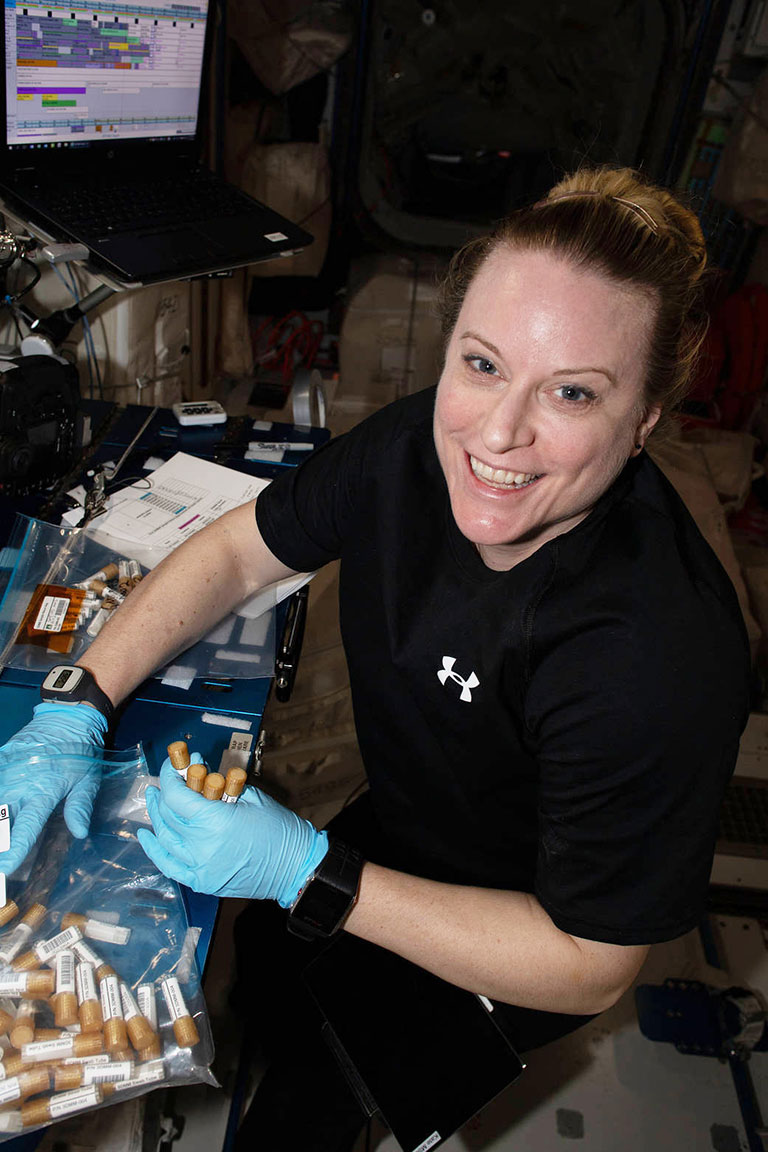
NASA astronaut Kate Rubins prepares surface-sampling kits for the most detailed microbial and chemical map of the ISS to date.
Media Credit: NASA
Venkateswaran calls the ISS investigation the next chapter in that history, akin to a forensic investigation. Researchers used two powerful techniques—untargeted metabolomics and genetic sequencing—to build the microbial map. The sequencing looked at all genes, as well as specific ones like 16S rRNA, a kind of molecular clock that helps scientists trace how organisms evolve and relate to one another. And like any good forensic case, it had its share of surprises.
In an earlier investigation, Venkateswaran and his team had discovered one hitchhiker, Pantoea pearsonii, clinging stubbornly to a surface inside the ISS. On Earth, the bacterium had previously been misidentified or labeled an emerging pathogen, but the team was able to fully characterize it from their ISS sample. Found in hospitals, it is resistant to frontline antibiotics, causing septicemia, kidney stones, and weeks of illness. It resurfaced on the space station in 2022 during the team’s ISS National Lab investigation.
“We haven’t been able to clean it up,” Venkateswaran says.
The microbes living on the ISS come from Earth, but adapting to space pushes them in new directions. Under radiation, microgravityThe condition of perceived weightlessness created when an object is in free fall, for example when an object is in orbital motion. Microgravity alters many observable phenomena within the physical and life sciences, allowing scientists to study things in ways not possible on Earth. The International Space Station provides access to a persistent microgravity environment., and confinement, some strains accumulate unique traits. A few have even diverged enough to classify as new species.
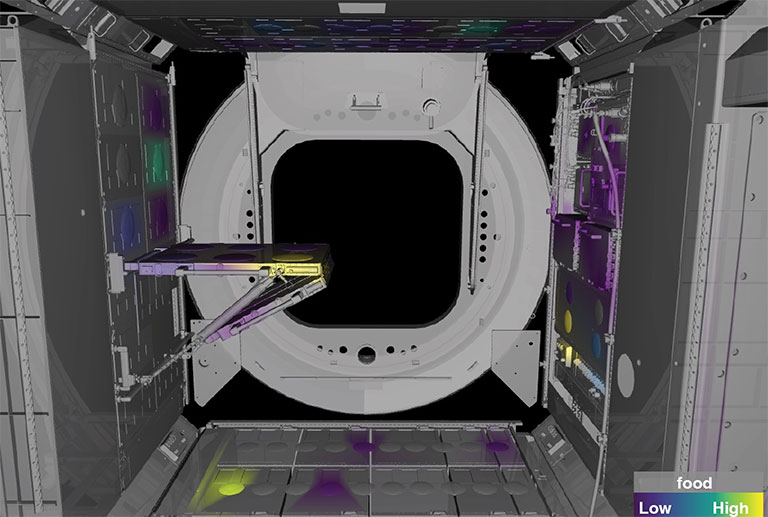
This visualization of the ISS Node 1 module shows where food-associated microbes accumulate during daily life in orbit, with analysis tracing each microbial signature to likely sources, such as food, crew, and equipment.
Media Credit: UCSD
Among others cataloged from the ISS were six pathogens on the World Health Organization’s “ESKAPE list,” a roster of organisms notorious for causing hospital outbreaks. Klebsiella pneumoniae was there, known for causing respiratory infections. Pseudomonas, was there too, a slippery organism capable of thriving on minimal nutrients. And all of them, when compared to their Earthly counterparts, carried an unnerving number of resistance genes, particularly against the beta-lactam antibiotics that hospitals rely on.
“I was surprised there were all these ESKAPE pathogens and viruses,” Foster said. “So there has to be a lot of monitoring to make sure good bacteria aren’t going bad.”
Scientists think those genes accumulate for a reason. Life on the ISS is harsh. Bacteria are constantly bathed in disinfectants, exposed to radiation, and forced into close quarters where they jostle against one another. Under that kind of pressure, microbes either adapt or die, and the adaptations that help them survive often involve genes that also blunt the effect of antibiotics.
Similar patterns appear in other sealed, human-dominated environments on Earth—surgical suites, hospital wards, even aerospace cleanrooms—where limited contact with the outdoors creates selective pressures like those on the space station. The ISS is a particularly unique example, but not an exception: once bacteria pick up those defenses in any such ecosystem, they have every chance to pass them along.
The chemical side of the study, however, carried more mysteries.
“Most of the recovered metabolites were unknown. They just have no idea what they are,” Foster said. “So many are black boxes, so to speak, or gaps in knowledge representing a challenge for us to understand.” Even among the metabolites documented in the study, a large portion could only be guessed at or flagged as “lipids” or “peptides” with little else to go on.
But the ISS is not a cesspool. It’s cleaner than most homes, just not as sterile as an intensive care unit. And that’s a good thing.
“If it’s too sterile, even minor pathogens become dangerous,” says Venkateswaran. “You need good microbes to balance the bad ones.” Foster agreed: in space, as on Earth, the goal isn’t minimizing microbes but fostering diversity, she says.
Venkateswaran once tried to persuade his Russian colleagues to collect samples from their half of the station, since he wanted to compare the microbial diversity of the two segments.
“The excuse was, ‘We don’t want to know,’” he recalled, amused. He noted that this attitude highlighted the culturally loaded nature of the truth that wherever people go, microbes follow.
Looking Ahead with Microbes in Mind
The persistence of pathogens like Pantoea pearsonii raises concerns for astronaut health, especially on long-duration missions to the Moon or Mars where evacuation is impossible. To mitigate risk, researchers are already thinking about how spacecraft and habitats might be designed with microbes in mind.
Standard DNA sequencing is too cumbersome for everyday diagnostics in space, so researchers are exploring alternatives. One idea is biosensors: instead of sequencing DNA, they would detect the chemical metabolites microbes emit, using miniaturized mass spectrometers already adapted for orbit. Venkateswaran envisions them working “like a smoke alarm,” alerting astronauts when a pathogen breaches the threshold. The same technology might one day monitor hospitals and schools for outbreaks.
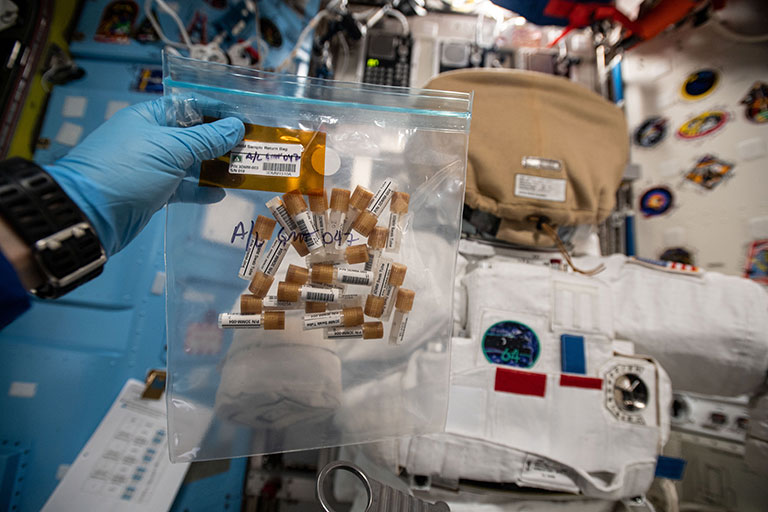
Close-up of the sampling tools used to swab surfaces across the ISS for the study.
Media Credit: NASA
For Zhao, the biggest surprise was the orderly patterns. Microbes didn’t drift chaotically but recorded the station’s routines. That consistency, she says, could guide the design of sensors and habitats alike, allowing layouts that limit spillover, airflow that prevents buildup in vents, and surfaces engineered to resist colonization.
Venkateswaran jokes that microbes will be the first true settlers of space. They travel light and thrive where we least expect them. Foster recognizes the stakes in that idea: on the Moon or Mars, the wrong infection could mean life or death. There’s no ambulance, no quick trip home. The ISS is a safeguard, she says, and remains our best testing ground for understanding long-term microbial behavior in space.
“It’s a fantastic resource for scientists. I hope we can find a way to keep it as long as possible, as this science is hitting its stride,” she said.
To Zhao, the ISS isn’t a sterile lab but a deeply human place, recorded in nearly a thousand microscopic fingerprints. Bacteria on surfaces, crumbs from space snacks, skin flakes sifting through recycled air. Every smear reminds us that wherever we go, microbes go, too. They don’t just cling to us, they map where we’ve been, and it will take understanding them to build a home off world.